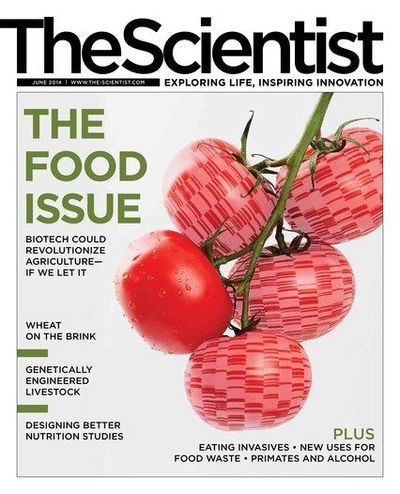Login
SubscribeCover Story

Putting Up Resistance
Kerry Grens | Jun 1, 2014 | 10+ min read
Will the public swallow science’s best solution to one of the most dangerous wheat pathogens on the planet?
Features

Designer Livestock
Jef Akst | Jun 1, 2014 | 10+ min read
New technologies will make it easier to manipulate animal genomes, but food products from genetically engineered animals face a long road to market.

Tactical Maneuvers
Stephanie Swift | Jun 1, 2014 | 10+ min read
Scientists are creating viruses that naturally home in on tumor cells while simultaneously boosting the body’s immune system to fight cancer.
Contributors
Contributors
Contributors
Meet some of the people featured in the June 2014 issue of The Scientist
Editorial
A Lot to Chew On
A Lot to Chew On
Complex layers of science, policy, and public opinion surround the things we eat and drink.
Speaking of Science
Speaking of Food Science
Speaking of Food Science
June 2014's selection of notable quotes
Notebook
Carpe Carp!
Carpe Carp!
Can putting invasive species on the menu contain troublesome animals and plants?
Barf-Less Brews
Barf-Less Brews
Genetic engineering could help keep harmful toxins out of barley and beer, but will consumers with a thirst for craft malts and brews buy into it?
Waste Not, Want Not
Waste Not, Want Not
Researchers and entrepreneurs divert food waste from landfills by turning it into a variety of ingenious products.
Parsing Pathogens
Parsing Pathogens
Meet the peptide-covered microcantilever device capable of differentiating subtypes of Salmonella.
Critic at Large
Wild Relatives
Wild Relatives
As rich sources of genetic diversity, the progenitors and kin of today’s food crops hold great promise for improving production in agriculture’s challenging future.
Thought Experiment
Digesting Dietary Data
Digesting Dietary Data
Why are there so many contradictory nutrition studies, and how can they be improved?
Modus Operandi
Film Stars
Film Stars
Engineered bacteria can shape electricity-conducting nanowires.
The Literature
Longevity Diet
Longevity Diet
Researchers unmask a gene that protects C. elegans from lifespan-shrinking metabolic byproducts.
Beneficial Brew
Beneficial Brew
Drinking green tea appears to boost the activity of DNA repair enzymes.
Nutrient-Sensing Neurons
Nutrient-Sensing Neurons
Using just three dopaminergic neurons, Drosophila larvae can sense whether a food source lacks a full roster of essential amino acids.
Profile
Mutagens and Multivitamins
Mutagens and Multivitamins
Not one to shy away from controversy, Bruce Ames has pitted himself against industry groups, environmentalists, and his peers through his work identifying DNA mutagens. And he’s not done yet.
Scientist to Watch
Haley Oliver: Master of Meat
Haley Oliver: Master of Meat
Assistant Professor, Department of Food Science, Purdue University, Age: 32
Lab Tools
Moving Target
Moving Target
New mass spectrometry–based techniques are blurring the lines between discovery and targeted proteomics.
Singularly Alluring
Singularly Alluring
Microfluidic tools and techniques for investigating cells, one by one
Careers
Simultaneous Release
Simultaneous Release
Coordinating the submission of manuscripts can strike a healthy balance between competition and collaboration.
Reading Frames
Drunks and Monkeys
Drunks and Monkeys
Understanding our primate ancestors’ relationship with alcohol can inform its use by modern humans.
Capsule Reviews
Capsule Reviews
Capsule Reviews
Proof, Caffeinated, A Sting in the Tale, and The Insect Cookbook
Foundations
Wheat Whisperer, circa 1953
Wheat Whisperer, circa 1953
The Green Revolution of the 20th century began with Norman Borlaug’s development of a short-statured, large-grained wheat.





















